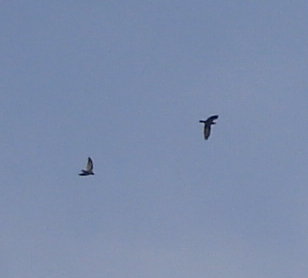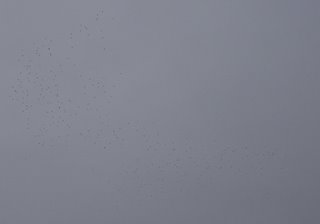Ring Ouzel - one, 15th
Tree Sparrow - two on 25th
Yellowhammer - two on 26th
Rock Pipit - five birds on four dates
Yellow-legged Gull - adult, 25th
Lapwing - one over, 11th
unprecedented visible migration
involving pipits, finches, thrushes, pigeons, corvids, larks, wagtails etc.
all records refer to Stoke Newington reservoirs unless otherwise stated
In stark contrast to September, October's weather was distinctly seasonal and changeable, with dominant weather systems changing every few days - hence, movements of birds ebbed and flowed accordingly.
Although dictated in part by the weather, skywatching for visible migration was the main theme of the month, and many hours were again put in to record flyovers and movements; before this year no efforts have been dedicated to overhead passage in the area, and so results were pleasantly surprising.

(Reed Bunting, Oct 2006)
Inspired in part by encouraging results in the spring and September, and the efforts of other observers at urban sites across the capital, records of both quantity and quality kept attentions easily focused on visible migration, which more than made up for the otherwise quiet month regarding grounded migrants and waterbirds.
However, a few species did manage to distract attentions back to the scrub, trees, reeds and open water. Geese were well represented by variable numbers of Canadas, usually between four and twenty; Greylags were more regular than usual, with five on 7th and five on 15th followed by a record site count of 42 west on 16th; while Egyptian Geese were less keen to visit this month, with a pair on 11th the only record.
Duck numbers, and species, were comparitively poor. Modest numbers of the common species on the East (and, to a much lesser degree, West) Reservoir rarely warranted counts, although Shovelers peaked with 30 on 7th, 18 on 25th, and 27 on 27th. Wigeons were present on 7th (one), 11th (nine) and 13th (two), and a single Teal flew west with Mallards on 25th.

(Greylags, Oct 2006)
Gull numbers began to build late in the month, with regular and heavy westward movements of mainly Black-headed Gulls at dawn on many occasions, with up to 200 recorded on several dates. Herrings and Lesser Black-backs were more numerous by the last week, with between five and 12 of each usually present. Common Gulls were present on 16th (two), 25th (one) and 27th (two); and an adult Yellow-legged Gull briefly graced the 'gull rings' on the morning of the 25th.
Warblers were practically non-existent, with three single records of Chiffchaff, two of Blackcap and one each of Willow Warbler (4th) and Reed Warbler (11th). Wader records were equally dire, with very high water levels on both reservoirs scuppering any vague chances of a surprise, or even the expected sandpipers and Snipe; the only representative of the family was a Lapwing - the first for several years - flying southwest on 11th.
Hirundines were few and far between, with six Swallows on 9th and a single on 15th, 34 Sand Martins on 7th and three on 11th, and 20 House Martins on 7th. A single Ring-necked Parakeet graced the Church Street entrance of the Cemetery on 26th.


(Jackdaws, Oct 2006)
One of the species of the month, and the first record for the site, was a Ring Ouzel, which left the trees in the SE corner of the ER, with Redwings, on the morning of 15th. Goldcrests were often present in small numbers, with an isolated peak of 15 on 13th. Yellow Wagtails were recorded on 4th (one) and finally on 11th (three).
For all the quietness on land and water, the skies were regularly entertaining (and often comparitively exciting) for such an urban site. The direction of movements, usually into a head-wind and often from the easterly half of the compass, indicate many species involved (especially those in large numbers) appear to orientate using the green space of the Reservoir area and then, for most part, head west/southwest/south (except on occasions of north or northwesterlies, when passage moved into the wind).
Whether or not the site is particularly good for visible migration, or is a traditional flight-path over east and north London, or whether this year has just been particularly good, all remains to be seen; but the strike-rate of the site, when compared to other local and potentially as-good locations, is now more than apparent.


(woodpigeon visible migration, Oct 2006)
The possibility of birds using the natural flight-path of the Lea Valley and then veering just west of south over the Reservoirs, perhaps when the 'end' of the valley is evident, is another possibility; future sessions during peak periods, both at the reservoirs and elsewhere nearby, will hopefully clarify the situation.
Finch movements were varied, and at times heavy. Greenfinch numbers sometimes exceeded 20, and occasionally over 30 birds; Chaffinches, meanwhile, were even more numerous, with ten to 25 per session in the first half of the month, and peaks of 40 (16th), 52 (25th) and 67 - a record count thus far - on 27th. Linnets were recorded on three dates, with two on 13th, six on 16th, and 13 on 25th.
Bramblings began to move through during the latter half of the month, with six on 15th, three on 16th, three on 25th and no less than 22 on 27th (including a flock of ....). Siskins were recorded on 9th (one), 13th (one) and 27th (eight), and 'redpolls' were seen on 7th (one), 15th (13) and 16th (two). Those which were seen grounded, which included most of those on 15th and the pair on the following day, were Lessers.

(House Martin & Swallow, Oct 2006)
While many finches, and other passerines, were flyovers, a varying percentage on each day tended to land and feed briefly in the trees, or fly low enough to consider the option; this was also the case with Meadow Pipits, which were again numerous this month. Of the 130 birds recorded, at least several on each day landed around the reservoir perimeter, at times immediatley alongside the observation point, or even in the reeds. The peak count came with 39 on 25th.
The records and behaviour of Reed Buntings during the month were interesting; while the species is regularly present in the reedbed on site, no more than one or two have been seen at a time for several months. However, visible migration sessions produced birds regularly arriving from the north or east (especially on days of heavy passerine passage), dropping in briefly to feed or rest, and then continuing their journey south or southwest.
Such records included two on 7th, three on 9th, five on 17th, four on 25th and six on 27th, all strongly suggesting a migratory presence through the site in autumn.
Skylarks were previously a barely annual rarity, and so a total of 11 over during the month (two on 15th, seven on 16th & two on 25th) again helped to make the local picture clearer.
Records of site scarcities came thick and fast, especially towards the month's end. In addition to the Ring Ouzel and Lapwing, a second local sighting of Rook came on 27th, with a single moving west with a large Jackdaw flock; and after previously being unrecorded, Rock Pipits were almost regular (!), with four records of five birds (11th, 13th & 27th, with two on 25th).
Heavy movements over London during the last week brought another two site firsts to the Reservoirs. Two Tree Sparrows flew low overhead on the 25th (perhaps alighting close by), and almost as locally exciting were two Yellowhammers, which meandered around the ER perimeter on the 27th before leaving to the south.
Quantity often went hand-in-hand with quality, with the best days providing both (and the worst providing neither!). Woodpigeons provided impressive spectacles of mass migration, with up to several hundred on most day counts, but unprecedented numbers flew west and south west in flocks often containing up to 300 by the end of the month. 1,695 on 25th was followed by 2,210 on 27th, perhaps the month's highlight from a visual perspective.

Stock Doves were probably under-recorded, but peaked with seven on 27th, while at least 20 Collared Doves - a site 'resident' in ones and twos - flew west on 27th (including a flock of 13). Local Carrion Crows were often supplemented by additional birds, with a peak of 26 (southwest) on 16th.
Jackdaws, like many other migrants, greatly surpassed their traditional 'occasional in very small numbers' status, with 122 birds recorded; peak day counts were 77 on 27th and 31 on 25th. Thrush movements, as expected, took on a more scandinavian feel during the month. Several nights of heavy Redwing passage during the second and third weeks of the month paved the way for large numbers recorded during early morning sessions, with a minimum of 301 birds counted.
Peaks came on 16th (81), 25th (143) and 27th (67), the latter date also providing the first three Fieldfares of the year. Song Thrushes were also numerous, often in double figures, with a high count of 24 on 15th.
All in all, a fascinating month, especially regarding the regular highlights of visible migration. If only the water levels were dropped by a metre or so....
Mark